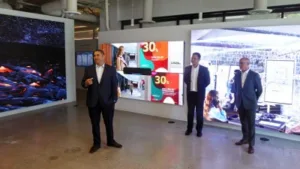Two weeks ago, I was invited to the grand opening of Samsung’s newest EBC facility in Irvine, California; a hop, skip, and a jump from John Wayne Airport. (No kidding, I walked about 15 minutes from the EBC to catch my return flight home!) EBC stands for Executive Briefing Center, but the facility would be better described as a showroom.

Samsung has filled it with examples of their LCD and LED products, a diverse offering that includes their 32:9 aspect ratio, super-wide (dual QHD) LCD gaming monitor to intelligent 8K displays, high-brightness LCD digital signage, and a variety of LED walls with pixel pitches starting at 1.5mm and fine-tuning down to 0.8mm.
 Mario DiAntonio starts the tour by Samsung LED walls – Image:Pete Putman
Mario DiAntonio starts the tour by Samsung LED walls – Image:Pete Putman
Samsung has become a global leader in display manufacturing and still sits atop the heap in market share of televisions shipped annually. The IHS Technology report, “Public Displays Market Tracker,” states that Samsung captured 25.8% of the global market share for digital signage unit sales in 2018.
Yet, the company sits at a crossroads of sorts today. LCD manufacturing, once a profitable business, doesn’t have the luster it once did. Just a few years ago, it was estimated that Samsung’s LCD panel manufacturing business in Korea was perhaps realizing one to two points of profit on finished LCD panels. There is speculation that the company may want to ease out of panel manufacturing, most likely sourcing the glass they need from their joint venture fab with TCL (China Star) or buying it on the open market.
Samsung is also looking at the bigger picture with respect to content consumption, making a decision this year to stop manufacturing Blu-ray players as more and more content delivery switches to the cloud and streaming model for both consumer and professional applications.
There’s no question the company wants to position itself as a leader in 8K television and displays. Their ISE booth featured a range of 8K display “solutions,” something we’re likely to see in Orlando next month. And on the LED side, the company appears to ramping up its efforts to manufacture and market fine pitch walls and tiles. They were also the first company to promote the use of LED walls for cinema with their Onyx product, a concept that has yet to catch on in the U.S. but is intriguing.
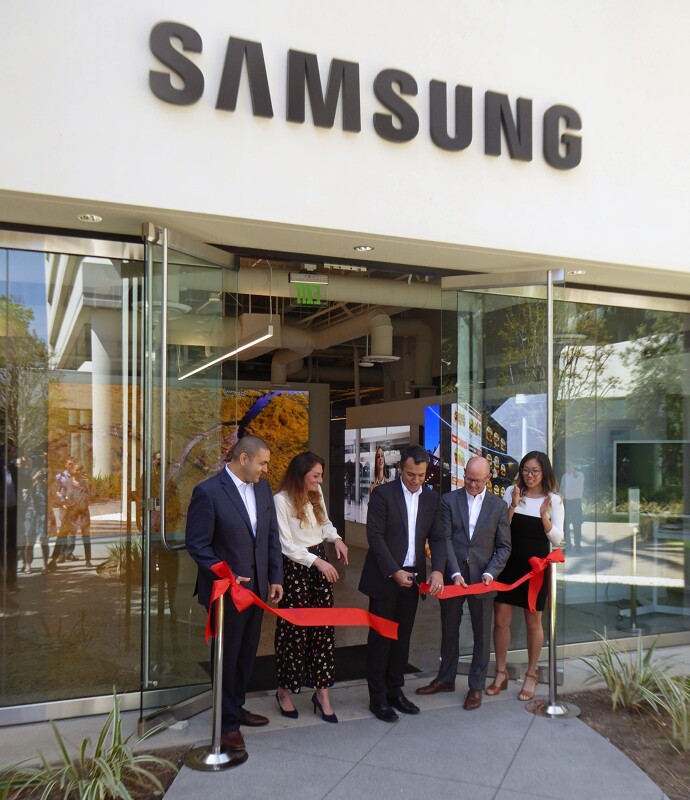 Ribbon cutting at Samsung EBC Irvine – Image Pete Putman
Ribbon cutting at Samsung EBC Irvine – Image Pete Putman
After the ribbon cutting, we got a guided tour of the EBC, led by Mario DiAntonio of Samsung. The LED Display IF Series is said to be able to reach peak brightness levels two to three times that of conventional LED walls without sacrificing color saturation and quality using something they described as “HDR scene adaptation technology.” I didn’t have any way to measure color accuracy or saturation, but what I saw looked promising.
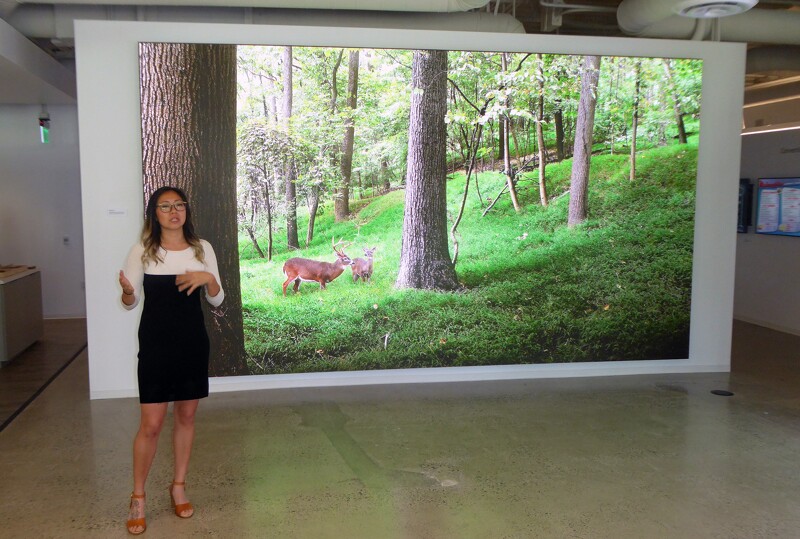 Samsung 1.2mm LED Wall can be viewed at 12 feet – Image:Pete Putman
Samsung 1.2mm LED Wall can be viewed at 12 feet – Image:Pete Putman
What didn’t look so promising was evidence of under sampling of colors on the 1.2mm wall, resulting in contouring in images that showed color gradations. Samsung personnel insisted it was a problem with the content and not the display video card and driver. There was also evidence of some latency between different tiles, as seen with moving images. Some tiles were updating a split-second after others, resulting in a judder artifact. There are still some bugs in the machine that need to be worked out.
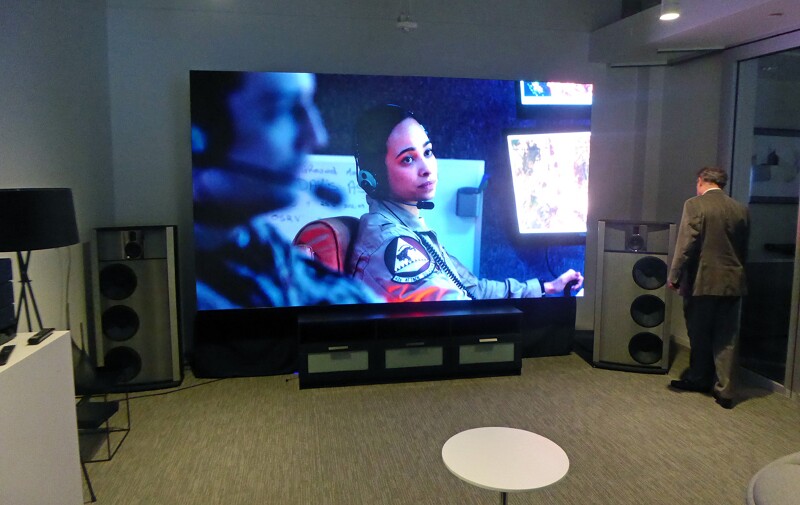 Samsung Wall Home Theater – Image Pete Putman
Samsung Wall Home Theater – Image Pete Putman
In the back of the showroom, Samsung built a home theater around its Wall product. This is a 10’ (3.05m) diagonal LED videowall with a pitch of 0.84mm and a peak brightness specification of 1600 cd/m². (I couldn’t verify what proportion of the display was white for that number) We were shown a variety of 4K video clips with HDR, ranging from deep shadows to brilliant sunsets, and plenty of fast motion sequences.
While The Wall certainly makes for an impressive home theater installation, its price tag isn’t for the faint of heart at nearly $400,000. And I can’t recommend sitting in a darkened room while watching a screen that bright, as it will cause fatigue in short order. Some time ago, folks at SMPTE were talking about 50 foot-lamberts as being the maximum desirable luminance level in a darkened theater, and that works out to about 170 cd/m² – almost 1/10th of the Wall’s rated luminance level.
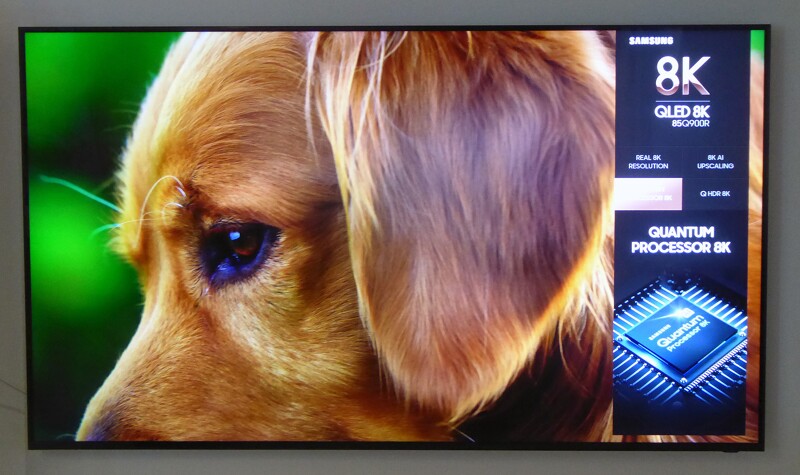 Samsung 8K Intelligent Display Image Pete Putman
Samsung 8K Intelligent Display Image Pete Putman
Samsung’s 8K Intelligent Signage system is based on their 85-inch LCD panel with a full array backlight harnessed to quantum dots, reaching a peak (in small points) luminance level of 4,000 cd/m². This display is also equipped with the company’s new AI scaling technology, announced at CES 2019. It’s supposed to take any mix of content and scale cleanly up to 8K, but the demos were all using native UHD content so we couldn’t judge its efficacy.
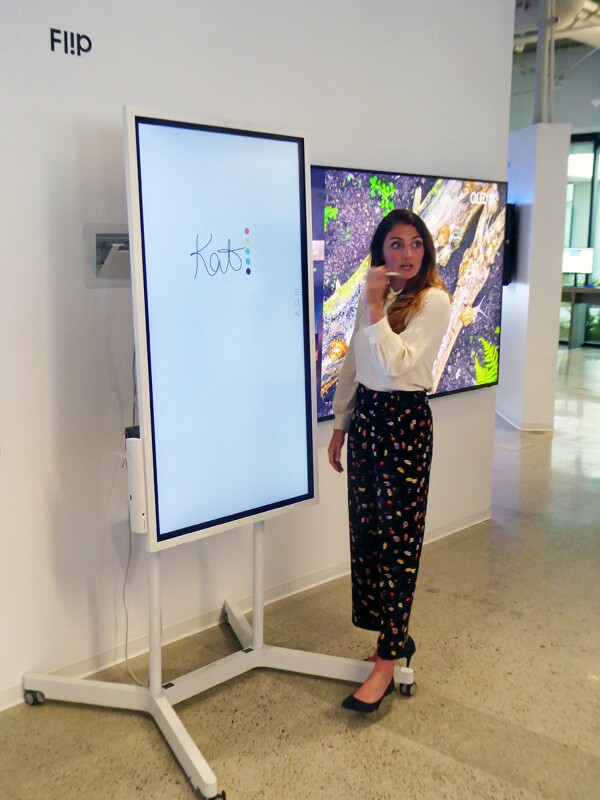 Samsung Flip Demo Image Pete Putman
Samsung Flip Demo Image Pete Putman
In addition to the 8K intelligent signage exhibit, Samsung also demonstrated their Flip 55-inch Ultra HD LCD touchscreen “whiteboard.” It can work horizontally or vertically and up to four users can simultaneously annotate on it, bring up documents and photos to review, and watch video clips. The Flip also supports screen mirroring from Android devices, as I verified by casting a few videos from my phone.
All in all, a nice demo of the company’s display prowess. The overall feel was similar to that of a showroom for interior and exterior decorating, with numerous options to fit a particular display application. Existing EBCs are already operating in New Jersey and New York City and more will open this year across the country, with the next one situated in Washington, DC.

